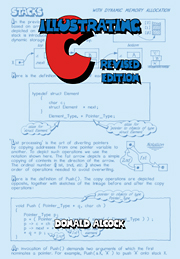Summary
The original C programming language was devised by Dennis Ritchie. The first book on C, by Kernighan and Ritchie, came out in 1978 and remained the most authoritative and best book on the subject until their second edition, describing ANSI standard C, appeared in 1988. In all that time, and since, the availability and use of C has increased exponentially. It is now one of the most widely used programming languages, not only for writing computer systems but also for developing applications.
There are many books on C but not so many on ANSI standard C which is the version described here.
This book attempts three things:
to serve as a text book for introductory courses on C aimed both at those who already know a computer language and at those entirely new to computing
to summarize and present the syntax and grammar of C by diagrams and tables, making this a useful reference book on C
to illustrate a few essential programming techniques such as symbol state tables, linked lists, binary trees, doubly linked rings, manipulation of strings, parsing of algebraic expressions.
For a formal appreciation of C – its power, its advantages and disadvantages – see the references given in the Bibliography. As an informal appreciation: all those I know who program in C find the language likeable and enjoy its power. Programming C is like driving a fast and powerful car. Having learned to handle the car safely you would not willingly return to the family saloon.
- Type
- Chapter
- Information
- Illustrating C , pp. ix - xPublisher: Cambridge University PressPrint publication year: 1994

